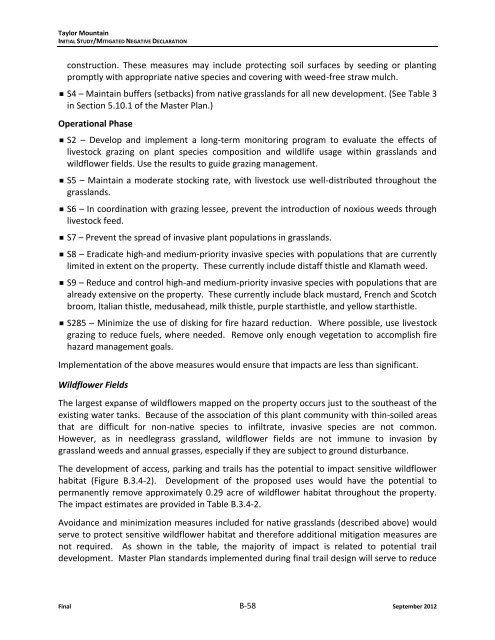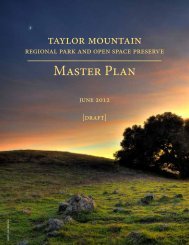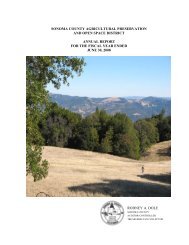Initial Study MND - Sonoma County Agricultural Preservation and ...
Initial Study MND - Sonoma County Agricultural Preservation and ...
Initial Study MND - Sonoma County Agricultural Preservation and ...
Create successful ePaper yourself
Turn your PDF publications into a flip-book with our unique Google optimized e-Paper software.
Taylor MountainINITIAL STUDY/MITIGATED NEGATIVE DECLARATIONconstruction. These measures may include protecting soil surfaces by seeding or plantingpromptly with appropriate native species <strong>and</strong> covering with weed-free straw mulch. S4 – Maintain buffers (setbacks) from native grassl<strong>and</strong>s for all new development. (See Table 3in Section 5.10.1 of the Master Plan.)Operational Phase S2 – Develop <strong>and</strong> implement a long-term monitoring program to evaluate the effects oflivestock grazing on plant species composition <strong>and</strong> wildlife usage within grassl<strong>and</strong>s <strong>and</strong>wildflower fields. Use the results to guide grazing management. S5 – Maintain a moderate stocking rate, with livestock use well-distributed throughout thegrassl<strong>and</strong>s. S6 – In coordination with grazing lessee, prevent the introduction of noxious weeds throughlivestock feed. S7 – Prevent the spread of invasive plant populations in grassl<strong>and</strong>s. S8 – Eradicate high-<strong>and</strong> medium-priority invasive species with populations that are currentlylimited in extent on the property. These currently include distaff thistle <strong>and</strong> Klamath weed. S9 – Reduce <strong>and</strong> control high-<strong>and</strong> medium-priority invasive species with populations that arealready extensive on the property. These currently include black mustard, French <strong>and</strong> Scotchbroom, Italian thistle, medusahead, milk thistle, purple starthistle, <strong>and</strong> yellow starthistle. S285 – Minimize the use of disking for fire hazard reduction. Where possible, use livestockgrazing to reduce fuels, where needed. Remove only enough vegetation to accomplish firehazard management goals.Implementation of the above measures would ensure that impacts are less than significant.Wildflower FieldsThe largest expanse of wildflowers mapped on the property occurs just to the southeast of theexisting water tanks. Because of the association of this plant community with thin-soiled areasthat are difficult for non-native species to infiltrate, invasive species are not common.However, as in needlegrass grassl<strong>and</strong>, wildflower fields are not immune to invasion bygrassl<strong>and</strong> weeds <strong>and</strong> annual grasses, especially if they are subject to ground disturbance.The development of access, parking <strong>and</strong> trails has the potential to impact sensitive wildflowerhabitat (Figure B.3.4-2). Development of the proposed uses would have the potential topermanently remove approximately 0.29 acre of wildflower habitat throughout the property.The impact estimates are provided in Table B.3.4-2.Avoidance <strong>and</strong> minimization measures included for native grassl<strong>and</strong>s (described above) wouldserve to protect sensitive wildflower habitat <strong>and</strong> therefore additional mitigation measures arenot required. As shown in the table, the majority of impact is related to potential traildevelopment. Master Plan st<strong>and</strong>ards implemented during final trail design will serve to reduceFinal B-58 September 2012







